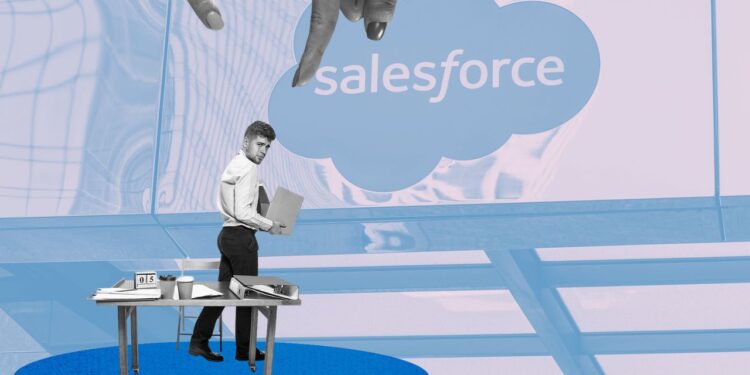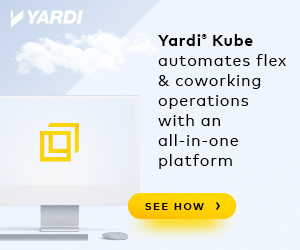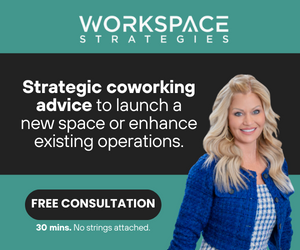- Leaders are worried about the professional growth and cultural integration of junior staff in hybrid and remote workforces, in part because the future of any organization depends on developing its junior staff into future leaders.
- A key component of a hybrid development and integration program involves on-the-job training, which can easily be done in a small-group style on selected in-office days, with one senior staff member helping train six to eight junior employees.
- Digital coworking helps to replicate the experience of working alongside coworkers in a shared office space, which is helpful for on-the-job training for junior staffers.
Shortly before the layoffs at Salesforce, Marc Benioff, cofounder and co-CEO of Salesforce, recently sent a company-wide Slack message complaining about the low productivity of recent hires made during the pandemic and asked “Are we not building tribal knowledge with new employees without an office culture?”
Salesforce permits a high degree of flexibility for employees: teams and their leaders make the choice about what kind of work arrangements suit their needs best. But does such flexibility threaten the development and integration of recently hired junior staff?
That’s a concern raised by many companies I advise on transitioning to permanent hybrid work arrangements. They recognize that research shows staff are more productive working remotely, but worry this may not apply to junior staff who have not yet learned the systems, processes, and practices of the company.
They also worry about the professional growth and cultural integration of junior staff. After all, the future of any organization depends on developing its junior staff into future leaders.
Thus, many leaders join Beinoff in expressing serious reservations about a flexible hybrid model. Instead, they advocate for a return to the office as a means of addressing such concerns and reinvigorating what Beinoff termed an “office culture.”
I tell such leaders that their concerns are real and need to be addressed. Yet there’s no reason to throw out the baby with the bathwater. Flexibility helps improve productivity and retention while cutting costs; it’s important and viable to find a win-win approach that retains these benefits while also facilitating the development of junior staff.
In fact, a full-time office return is likely to have a negative effect on junior staff, not a positive one. According to the ADP Research Institute report, “People at Work 2022: A Global Workforce View,” Gen Z are the most likely age group to say that “if my employer insisted on me returning to my workplace full-time, I would consider looking for another job,” at 71%. By contrast, 56% of those 45-54 said they would consider looking for another job.
Targeted solutions are the most effective
Instead, the solutions I work on with clients involve a more targeted approach customized to the needs of junior staff. It does involve newer staff coming into the office more often, but not simply randomly: they’re not going to just pick up the culture and work habits of a company by osmosis, especially given that more experienced staff won’t be coming in as often as junior staff.
What’s needed is a deliberate, intentional, and structured program to facilitate their development and integration into company culture while maintaining flexible hybrid work arrangements. This policy is distinct from a company’s onboarding program, but should build on and plug into it, so that junior staff transition seamlessly from the onboarding program in their first several weeks into the development and integration program for the first couple of years.
A key component of a hybrid development and integration program involves on-the-job training. Such training comes primarily in the form of senior staff responding immediately to questions and concerns raised by recent hires: showing them how to do the tasks associated with the role, guiding them into best practices and unwritten rules and norms, and introducing them to important internal and external stakeholders. Likewise, such training involves senior staff observing the performance of junior staff and proactively providing them with feedback and suggestions for improvements.
Fortunately, such on-the-job training can easily be done in a small-group style, with one senior staff member helping train six to eight junior employees. It takes having senior staff members coordinate schedules with junior staff to come to the office on the same days, and then work in the same open office space.
All of the employees will work on their individual tasks. When a recent hire has a question, they ask it, and the experienced employee will answer and explain the context; doing so ensures that the whole group gets the benefit of the explanation, without the senior staffer having to repeat it for each person in a one-on-one training setting. Additionally, the senior staff member will occasionally walk around and check in on the tasks of junior staff members, providing them with guidance and coaching as needed. Again, this helps the whole group learn how to do this task.
Who should train new employees to best help them integrate?
This kind of activity does impede the efficiency of senior staffers, and needs to be considered in their performance evaluations as a service to the company. But this impediment is relatively small, because of a one-to-many dynamic of teaching many recent hires at once. No one person should be overburdened with training: this task should be distributed among a number of senior staffers known as good on-the-job trainers.
It’s helpful for junior staff to get on-the-job training from a variety of senior staff members rather than from just a single individual; recent hires get multiple perspectives and tactics for accomplishing work outcomes, while also learning about and connecting with different networks and stakeholders within a company.
As part of the development and integration program, it’s also helpful to provide formal mentoring for newer employees. Most of the mentoring should take place in the office, since it’s easier to have conversations where recent hires can be vulnerable and admit lack of confidence face-to-face, rather than by videoconference.
Make sure to have one senior staff member from the junior colleague’s immediate team. The goal of the senior person within their own team is to help the person with on-the-job learning specific to the team’s tasks and with understanding team dynamics. Also include two from outside the team. One should be from the junior staff members’ business unit, and another one should be from a different unit. At least one should be located in a different geographical area, if the company is large enough.
These two mentors will be needed to overcome one of the key problems uncovered by research on company culture in hybrid work: the decrease in cross-functional connections across staff.
Having three mentors decreases the burden on each, allowing meetings of once or twice a month with each. As a result, such formal mentoring is easily manageable for experienced employees.
Strategies to mentor remote employees
What about the days when recent hires work remotely? To facilitate on-the-job learning through virtual settings, as well as to promote effective team collaboration, employ digital coworking. It involves team members spending an hour or two per day working on their own tasks while on a videoconference call with their teammates.
To start a digital coworking session, team members should first join a videoconference call. During this call, each team member should share their plans to work on their own tasks for the session and then turn off their microphone while keeping their speakers on, with video optional.
Then, team members work independently on their own tasks while still being able to communicate with each other by turning on their microphone if they have a question or comment. More experienced team members would then respond to the question, including using screensharing or a virtual whiteboard to demonstrate how to complete a task. Digital coworking helps to replicate the experience of working alongside coworkers in a shared office space, which is helpful for on-the-job training for junior staffers.
Benioff isn’t wrong to call out the challenges in developing junior staff in a hybrid setting. Yet the solution doesn’t involve returning everyone to the office to ensure an “office culture.” Instead of a broad-brush approach that sacrifices flexibility, and its benefits for retention, productivity, and cost savings, my clients find it helps to have a narrow, targeted approach that addresses the problem.
The solution is a structured program that transitions recent hires smoothly from onboarding in the first several weeks into integration and development for the first couple of years, with in-office on-the-job training and mentoring, along with digital coworking.

 Dr. Gleb Tsipursky – The Office Whisperer
Dr. Gleb Tsipursky – The Office Whisperer Cat Johnson – Coworking Marketing Maven
Cat Johnson – Coworking Marketing Maven Angela Howard – Culture Expert
Angela Howard – Culture Expert Drew Jones – Design & Innovation
Drew Jones – Design & Innovation Andrea Pirrotti-Dranchak – Competitive Advantage
Andrea Pirrotti-Dranchak – Competitive Advantage Jonathan Price – CRE & Flex Expert
Jonathan Price – CRE & Flex Expert Jeremy Fennema – Tech Innovation Alchemist
Jeremy Fennema – Tech Innovation Alchemist







